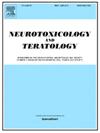大鼠妊娠期暴露于镉和苯并[a]芘的持续神经行为后果
IF 2.8
3区 医学
Q3 NEUROSCIENCES
引用次数: 0
摘要
环境中的神经毒性风险来自许多有毒物质,这些有毒物质通常以复杂的混合物形式存在。然而,几乎所有的实验研究都是一次评估一种化学物质。发育暴露于重金属如镉(Cd)和多环芳烃(PAHs)如苯并[a]芘(BaP)的神经行为影响已经得到了很好的研究,但是它们的非加性或相互作用的潜力尚不清楚。我们最近报道,在斑马鱼中,胚胎暴露于多环芳烃苯并[a]芘(BaP)和/或重金属氯化镉(CdCl2)会导致选择性的亚加性行为效应。目前的研究是在大鼠身上进行的,以确定这种相互作用是否会转化为哺乳动物,并更好地解释生物性别等特征。在本研究中,我们在整个妊娠期间通过渗透微型泵将雌性大鼠暴露于BAP (0.03 mg/kg/day)、金属盐CdCl2 (0.3 mg/kg/day)或两者中。评估雄性和雌性后代的身体和反射发育、运动、情感和认知功能。Cd治疗与新生儿肛门生殖器距离的性别差异受损、PND7负地向性表现增强、断奶时体重减轻、在高架+迷宫中张开手臂探索增加(仅限女性)以及新物体识别的性别差异减少有关。与BaP共同处理可减轻cdcl对负地向性和升高正迷宫的影响。BaP还与新环境抑制进食任务中食物消耗指标的减少以及桡臂迷宫训练初始阶段错误的增加有关(仅限雄性)。与斑马鱼一样,长期暴露于BaP和CdCl后的大鼠也出现了持续的神经行为效应。然而,这些影响可能在单次暴露和混合暴露之间有所不同,这表明需要更清楚地了解这种混合物中的相互作用。本文章由计算机程序翻译,如有差异,请以英文原文为准。
Persisting neurobehavioral consequences of gestational exposure to cadmium and benzo[a]pyrene in rats
Neurotoxic risks in the environment come from many toxicants, which are often found together in complex mixtures. However, nearly all experimental studies evaluate one chemical at a time. Neurobehavioral effects of developmental exposure to heavy metals such as cadmium (Cd) and polycyclic aromatic hydrocarbons (PAHs) such as benzo[a]pyrene (BaP) have been well-studied, however their potential for non-additive or interactive effects are not well known. We recently reported that, in zebrafish, embryonic exposure to the PAH benzo[a]pyrene (BaP) and/or the heavy metal cadmium chloride (CdCl2) led to selective sub-additive effects on behavior. The current study was performed in rats, to determine whether such interactions translate to mammals and to better account for characteristics like biological sex. In this study, we exposed female rats to BAP (0.03 mg/kg/day), the metal salt CdCl2 (0.3 mg/kg/day) or both via osmotic minipumps throughout gestation. Male and female offspring were assessed for bodily and reflex development, and locomotor, emotional and cognitive function. Cd treatment was associated with impaired sex differences in neonatal anogenital distance, enhanced negative geotaxis performance on PND7, reduced body weight at weaning, increased open-arm exploration in the elevated plus maze (females only), and reductions in sex differences in novel object recognition. Co-treatment with BaP attenuated those CdCl-effects on negative geotaxis and elevated plus maze. BaP was also associated with reduced metrics of food consumption in the novel environment suppressed feeding task, and with increases in errors during the initial phase of radial arm maze training (males only). As in zebrafish, persisting neurobehavioral effects are seen in rats after chronic developmental exposure to BaP and CdCl. However, these effects can differ between single-exposures and mixtures, which indicates a need for greater clarity on interactions within such mixtures.
求助全文
通过发布文献求助,成功后即可免费获取论文全文。
去求助
来源期刊
CiteScore
5.60
自引率
10.30%
发文量
48
审稿时长
58 days
期刊介绍:
Neurotoxicology and Teratology provides a forum for publishing new information regarding the effects of chemical and physical agents on the developing, adult or aging nervous system. In this context, the fields of neurotoxicology and teratology include studies of agent-induced alterations of nervous system function, with a focus on behavioral outcomes and their underlying physiological and neurochemical mechanisms. The Journal publishes original, peer-reviewed Research Reports of experimental, clinical, and epidemiological studies that address the neurotoxicity and/or functional teratology of pesticides, solvents, heavy metals, nanomaterials, organometals, industrial compounds, mixtures, drugs of abuse, pharmaceuticals, animal and plant toxins, atmospheric reaction products, and physical agents such as radiation and noise. These reports include traditional mammalian neurotoxicology experiments, human studies, studies using non-mammalian animal models, and mechanistic studies in vivo or in vitro. Special Issues, Reviews, Commentaries, Meeting Reports, and Symposium Papers provide timely updates on areas that have reached a critical point of synthesis, on aspects of a scientific field undergoing rapid change, or on areas that present special methodological or interpretive problems. Theoretical Articles address concepts and potential mechanisms underlying actions of agents of interest in the nervous system. The Journal also publishes Brief Communications that concisely describe a new method, technique, apparatus, or experimental result.

 求助内容:
求助内容: 应助结果提醒方式:
应助结果提醒方式:


